Practical Approach to Punishment
I have been thinking for a while about how to approach writing a blog about physical punishment that was more pragmatic and less emotional. I think a lot of times the arguments against using physical punishment are based in emotion and empathy to an animal experiencing pain/discomfort and while it’s still a good reason to avoid physical punishment, there are other reasons. I have tried writing this post off and on for quite a few months and have trashed posts more times than I would like to count. Fortunately, I think after a road trip this past weekend, I have an angle from which to start writing.
As many of you know, I have a new foster puppy who came to me because he has some behavioral challenges. Well, part of the behavior modification plan has been extensively socializing him with socially appropriate adult dogs who will appropriately correct him for rude doggie behavior. Unfortunately, these types of dogs are few and far between which has left me traveling an hour and a half to Indiana, PA and 2 hours to Cleveland to get in socialization time with a wide variety of dogs.
I decided to drive to Cleveland on a holiday weekend to visit a few friends with their dogs. I have driven this stretch of road (various distances) many times in the years that I have been a driver. I can honestly say that the vast majority of time, I can drive the PA/OH turnpike without seeing more than one or two state troopers (most often in OH). This Saturday, however, I saw well over a dozen state troopers between both states, 4 of them actively pulling people over (I lost track after I counted 15).
You might be wondering what the heck this has to do with dog training, well, hang on, I’m getting there!
So, historically speaking, on this stretch of road, there is very little chance of being pulled over and given a ticket (for me this process has both positive punishment and negative punishment). Without the risk of punishment, I do not always strictly follow the speed limit. I’m not zipping at 85mph and zigging/zagging through traffic, but strictly speaking, I may keep up with the flow of traffic while in the right lane even if that is above the speed limit.
While driving in PA on my way to OH I came across 3 state troopers, as soon as I spotted them hiding on the sides and in median area of the roadway, I checked my speed and if needed, slowed down prior to crossing their paths. After each trooper, the flow of traffic gradually increased their speed to their prior cruising speed. I only changed my behavior when the risk of punishment was in sight, when it wasn’t present, I was breaking rules.
As soon as I hit OH, I passed 3 cop cars in a speed trap–when I passed the cars, I was not speeding but you can bet I checked my speed. It wasn’t another 10 miles before I hit another two troopers (one in each direction). Although I still wasn’t speeding, after these two troopers, I decided to not keep up with the flow of traffic and instead just stay the speed limit because there were clearly a ton of cops out on the roads looking for drunk and/or dangerous drivers.
It was only when the threat of punishment was present that my behavior changed in that particular instance. My behavior only changed in a more long-term fashion when the threat of punishment was a constant threat (frequent state troopers). Without the threat of punishment, I was breaking the rules. This is the problem with relying on punishment in dog training. If you rely on punishment to get your dog to behave, as soon as the situation presents itself where the punishment is not possible, the reliability of a behavior completely falls apart (if not immediately, once they realize the threat of punishment has been removed).
I see this a lot with dogs who are on prong collars or shock collars or dogs whose handlers utilize leash corrections–as soon as the collar and/or leash is off, the dog fails to comply and is often completely out of control. Leash and/or collar on and the dog recognizes that the potential for pain/discomfort is present, but once these are removed, he has no reason to listen.
Any behavior that is motivated by the threat of punishment is more likely to fail when the possibility of punishment is removed because the motivation is also removed.. I think this is an incredibly dangerous situation because for most people, the moments they most need their dog to respond happen when a leash is dropped, a collar is broken, or a dog dashes out of a door and is loose. It is so important that we motivate our dogs with something other than the threat of punishment because if you don’t have the tools of punishment on hand, there is a good chance the behavior will break down.
What is interesting is that punishment mostly needs to happen every time an unwanted behavior occurs (at least initially or unless a very high level of punishment is used–high enough that single event learning happens). If sometimes a behavior is punished and sometimes it is either rewarded or nothing bad happens, most dogs will continue to gamble on performing the behavior in hopes of getting rewarded the next time. It is only when the behavior is punished every single time that the behavior will change. Dogs jumping up is a great example, if you are choosing to use punishment to correct jumping, you have to punish the jump up every time it happens or else they will continue to jump up, since sometimes it pays out.
Rewarding behavior is quite a bit different, almost the exact opposite as using punishment, it is not something that needs to happen every time in order for a dog to continue to offer a behavior (once the dog has learned the skill). Humans can utilize various reward schedules to teach a dog to gamble on the reward–dogs learn that not every behavior earns a tangible reward but to keep trying because eventually a tangible reward will happen, and sometimes an extra special jackpot will happen. Some rewards (of varying levels) are also very easy to provide on or off leash and even at great distances so dogs can easily learn to gamble while on or off leash. Dogs are excellent gamblers and will continue trying for a payout, even if they only win sporadically. THIS behavior is very easily seen in dogs who counter surf. They may have tried and failed for a full month, but one forgotten bagel and the dog’s hope will be renewed and they’ll keep trying–rewards come months apart but the behavior remains strong.
It is far more prudent, in my opinion, to motivate dogs with the potential for good things than the threat of bad things, not just because it’s more dog-friendly, but also because I do think it is more reliable. Dogs are willing to gamble on “maybe this time I’ll get a reward” and that is something that plays in our favor every time and punishment simply doesn’t work that way. For punishments to be effective in modifying behavior, they have happen consistently and then the threat of punishment needs to remain present to maintain behavior–if the tools of the punishment are absent the behavior will eventually break down. Dogs are natural gamblers and if rewards have been used correctly (not as bribes) you don’t need to have rewards on you to have compliance, “maybe this time she will give me a treat and pet me me when I sit instead of jumping up” (this is something baby Loki was doing all weekend while visiting friends, he got rewarded probably less than 50% of the time with either treats or petting but he still kept trying–with only the occasional jump).



Trackbacks/Pingbacks